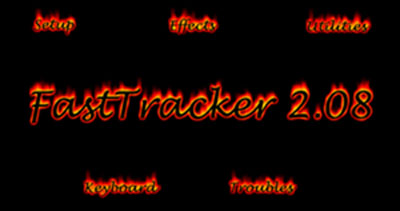 |
 |
| Setup | Back Up |
|
Setting up your devices First thing you must do when you start FastTracker 2.08 is Entering the Configuration screen. You can do so by clicking the button on the main screen called "Configuration". Now it's time for you to pick your output and sample devices. You do this by left-clicking on the button besides the soundcard you possess. If you are using a Soundblaster or Soundplayer you might wanna change the mixing frequency or else your tunes will sound very bad. If you own a 486 PC or better with a Soundblaster (classic, Pro, or 16) or a Soundplayer you can use Interpolation to get better sound quality. To improve soundquality you can enable the 16-bit mixing, this enhances the precision in the mixing routine but it requires more CPU time. You can also enable Stereo, but then your Soundblaster Pro cannot play more than 22050 Hz. And while we're at the frequency, the frequency table works like this : the linear frequency table makes all pitch bends to run in constant speed, independent of the current frequency. If you switch this one, on a finished song, it might sound strange if the sound uses portamentoes. Layout Press "Layout" at the left of the screen, to get to the Layout section of the setup. Pattern Layout Patternstretch,
to insert five pixels between every pattern row Mouse Shape For your mousepointer-look you can simply choose between four different pointers, there are also two busy pointers available, a sand-glass (Vogue) and a clock (Mr.H) Pattern Modes Show Volume
Column,
shows / hides the volume column, this is of use when you are composing
a .MOD module. Keyboard Layout This option changes the results in the text edit boxes. All other keyboard functions will remain the same in all layouts. Setting up DPMI mode If FastTracker is not working properly, you should run the program in plain DOS. You should also disable background execution, for avoiding problems when switching between tasks. Screen savers also might cause problems. In config screen #1 there's a drag box named "Maximum DPMI memory". This is the maximum amount of memory FastTracker allocates from the system. It is used for limiting the amount of memory allocated when sampling or reading data from CD-ROM. Also note that the measured amount of free memory is not working under DPMI Instead, it shows the memory allocated from the system, but not actually used. |
|
| Effects | Back Up |
|
In this part I assume that you have worked with trackers before so you know what a Volume Column is, and where to find it. Now for the Effects : Appergio, Syntax : 0 + 1st halftone + 2nd halftone Example
:C-1
1 -- 037 Portamento Up, Portamento is used to slide the sample pitch up or down. This is done using the period value. If Amiga frequency table is used, the sliding will be non-lineair ( the speed depends on the frequency). Syntax :1 + speed Example
:C-5
1 -- 103
|
|